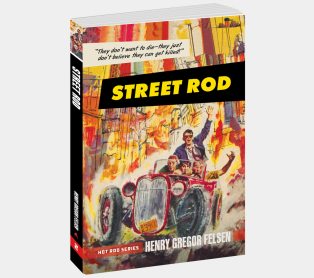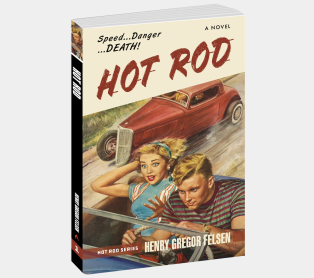Tight Race

The following is an excerpt from Road Rocket, by Henry Gregor Felsen. Woody Ahern had a job after school, he had saved a little money, and, the main reason he and the other members of his car club wanted a car was so that they could work on it. Woody would get his car. He named it Sidekick, and he lavished it with love and devotion. He was sure that when it was done it would be the most beautiful car imaginable. He could even see himself driving Sandra to the spring dance . . . but it would take a lot of work before Sidekick was safe to drive. In this excerpt, read about Woody as he street races and gets into a bit of trouble with the boys in the car next to him.
Main was a one way street, just wide enough for four cars to run side by side. And that was how they ran. There was very little normal traffic at this hour. Ninety percent of the cars were driven and occupied by boys and young men. Only a few had girls along or had the look of having a destination or a goal. Most of them were very obviously on hand to compete in the stoplight grand prix. Four rows wide and three rows deep, with a few stragglers behind the main pack, the cars waited impatiently for the light to change to green.
There were, in this tight jam-up, cars of every age and description. There were brand new convertibles with continental kits, cars that had been lowered, raked, dechromed, or adorned with original chrome arrangements. There were cars with factory power packs and cars that carried, under old, conservative exteriors, powerful engine and transmission swaps from original equipment. The one thing all these cars—new and old, modified or stock—had in common was their ability to make noise. If nothing else had been done to a car, the owner had at least replaced stock mufflers with glass or steel packs.
Situated roughly in the middle of the pack, Woody pressed his clutch pedal to the floor and revved his engine as the others were doing. Sidekick’s harsh blast joined the deafening mixture of mellow pipes, throaty pipes, high-pitched pipes, and snarling pipes.
“EeeeeYOWeeeee!” Sonny screamed from the back seat. “This is like a start at Ranger Park Raceways!”
Woody permitted himself a tight grin. That’s just what it was like, he thought. It was like waiting for the green flag with engines revving and roaring, a duel of cars and drivers. If he had ever had any doubt about wanting to be a race driver, that doubt was gone now.
A dozen engines wound up tight. Tire screeches cut through the deeper engine noises. Clouds of smoke rose up. They were off! Woody gave Sidekick the gas and eased out the clutch. The old car lurched forward, yielding to no other machine in the amount of noise it made per mile per hour. The newer and more powerful cars shot ahead. Woody found himself bringing up the rear in company with two other old cars that breathed more smoke than fire. His engine screaming as though ready to fly apart, Woody engaged in a grim duel with a 1948 Chevy on his left. He went all out in low, snap shifted awkwardly into second, and gunned his car. For a moment he and the Chevy ran a dead heat, and then slowly but surely Sidekick nosed ahead.
“You got him!” Sonny yelled as Woody pumped his brake.
The pack ahead had come to a stop. Woody roared up to it in low gear and eased his way into a hole, ready to choose another car. His heart pounded, his mouth was dry, and his palms were sweaty.
“What do you mean, him?” Dick said to squelch Sonny. “There was a woman driving that Chevy.”
“The car wasn’t a woman,” Sonny protested.
“How do you know she was racing with us? Maybe she wasn’t even trying.”
“She was trying, all right,” Woody said. But the edge had been taken off his victory.
He glanced to his left. He had pulled up even with and close to a rough looking car with four boys in it. They were in their late teens or early twenties, and they were looking back at him as though sizing him up. They looked contemptuous and hostile. Woody took a firm hold on the wheel. The front seat was so loose that every time he accelerated, the seat sagged back as though it were going to topple over.
“Watch me take these guys,” Woody muttered to Dick.
“Watch out for them,” Dick said. “They look mean.”
“Yeah,” Woody said. “You think they’re the ones who’ve been going around beating up people?”
“They’ve got that look. Don’t crowd ’em.”
“We’ve got as much right to be on the street as they have,” Woody said stubbornly.
“You’re asking for it, Woody . . .”
The light changed, and all the cars charged ahead. Woody charged with them, but they pulled away from him with ease. The car on his left stayed close, trying to force him over, but Woody held a straight course. He thought, for a moment, he was holding his own. Then the other car shot ahead and cut in front of him, braking immediately. Woody hit his brakes, but they weren’t good enough. His car weaved as the brakes grabbed unevenly, squealed, and then faded. Helpless, Woody bumped into the other car.
“Now we’re gonna get it,” Dick said.
He took hold of the door handle, ready to run. The boys in the car ahead looked back threateningly, but they stayed in their car.
“They did that on purpose,” Woody said. “They’re looking for an excuse to rough us up.”
Sonny’s voice came unhappily from the back seat. “Let’s get out of here, Woody. We’re no match for those guys.”
This title is part of the Retro Reads series. The collection reissues high-quality narrative titles and introduces them to a new audience. With this series, motoring enthusiasts will delight in familiar classics and discover new, dynamic narratives. Check out the related books linked below for more rodding adventures.





